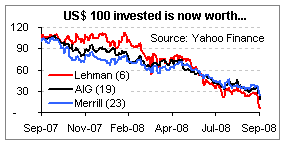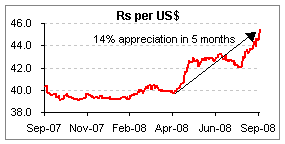Once in a century crisis & more...
In this issue:
» US financials fight for life
» Once in a century crisis, says Greenspan
» Going the Japanese way
» Private equity flocks to healthcare
» ...and more!
------- SPECIAL OFFER -------
Power Crisis Imminent
Here's How You Can Benefit From It. Read On...
---------------------------------------
| 00:00 |
Wall Street biggies fighting for life |
- "Lehman Brothers to file for bankruptcy" says the Financial Times.
- "Bank of America agrees to buy Merrill for US$ 50 bn after shares plunge" reports Bloomberg.
- "AIG scrambles to raise cash, talks to Fed" writes the Wall Street Journal.
All in all, it is a fight for life for these Wall Street financial firms, which have otherwise been the symbols of capitalism for so many decades. As these companies fight to stay afloat, investors in them are scurrying to save the last bit of their invested capital. Take for example Lehman Brothers, which, burdened by US$ 60 bn in soured real-estate holdings, has said that it is filing for Chapter 11 bankruptcy.
The New York Times has reported that this 158-year-old investment bank's fate appears sealed after the top contenders to purchase it, including the UK's Barclays walked away saying they will not support a deal that did not include financial backing from the US government or other banks.
Lehman's shares have shed almost 80% over the course of the past one week! The severity of the current crisis can be gauged from the fact that Lehman had earlier survived railroad bankruptcies of the 1800s, the Great Depression in the 1930s and the collapse of Long-Term Capital Management a decade ago.
 Turning to AIG, the world's largest insurance company has asked the Federal Reserve for a cash infusion of US$ 40 bn to fund its survival plan (which also includes selling off some of its valuable assets). As a matter of fact, the insurer has already raised US$ 20 bn in fresh capital so far this year. The turmoil in housing and credit markets has hammered AIG largely because of contracts it sold protecting others against losses tied to subprime loans and other risky assets. The company's stock has fallen nearly 80% this year (31% on Friday alone). Its combined losses for the first two quarters of this year stood at over US$ 13 bn.
Turning to AIG, the world's largest insurance company has asked the Federal Reserve for a cash infusion of US$ 40 bn to fund its survival plan (which also includes selling off some of its valuable assets). As a matter of fact, the insurer has already raised US$ 20 bn in fresh capital so far this year. The turmoil in housing and credit markets has hammered AIG largely because of contracts it sold protecting others against losses tied to subprime loans and other risky assets. The company's stock has fallen nearly 80% this year (31% on Friday alone). Its combined losses for the first two quarters of this year stood at over US$ 13 bn.
While 9/11 shook the US' territorial invincibility in 2001, 14/11 this year has shaken the country's stand as the world's financial nerve centre. As Jim Rogers has indicated, "Balance sheets of many of these financial institutions are still terribly impaired and there are more problems to come. We had the worst credit bubble in the history of the world. You don't clean that out in a year or two or three."
The sad fate of these beleaguered firms is a cautionary tale of what's gone wrong with Wall Street. Do we say any more?
| 01:43 |
One more heavyweight up for sale |
The WSJ reports that - "the deal does not come without risks. Merrill Lynch, like many of its Wall Street peers, has been struggling with tight credit markets and billions of dollars in assets tied to mortgages that have plunged in value. Merrill has reported four straight quarterly losses, and its stock has been sliding."
Even the financial situation of Bank of America is far from healthy. The bank has seen its profits decline over the past few quarters owing to deteriorating consumer credit situation. Also, the bank has still not fully integrated the troubles mortgage lender Countrywide Financial, which it had acquired early this year. Now the opportunity for making it big in investment banking has not necessarily come in at the best time for the bank.
| 02:17 |
"Once in a century crisis", says Greenspan |
The Fed's former Chairman's critics have said that he helped inflate the housing bubble by keeping short-term interest rates too low for too long, leading to reckless lending and borrowing in the housing market. However, Greenspan retaliated by indicating that the problem lay not in the loans themselves, but in their repackaging as securities and sale to investors.
Readers would do well to remember that the current financial crisis has its roots in the Fed's aggressive rate cutting stance beginning 2001, at the end of the Internet boom and following the September 11 terrorist attacks in the US. The Fed pumped money into the US economy and slashed its key short term interest rate - the Federal Funds rate - from 3.5% in August 2001 to a mere 1% by mid-2003. The Fed held this rate too low for too long, thus leading to incessant and reckless borrowing by consumers, even by those without a proper credit history.
Even commercial and investment banks created new financial mechanisms to expand housing credit to borrowers with little creditworthiness. The Fed declined to regulate these dubious practices. Virtually anyone could borrow to buy a house, with little or even no down payment, and with interest charges pushed years into the future. And the rest, as they say, is history!
| 03:10 |
Will the world be more like Japan? |
Interestingly, the fund thinks that emerging countries shall displace the G-7 as the world's largest economies over the next two to three decades. It also believes that emerging countries are going to exert a lot of pressure on natural resources and the resulting resource nationalism will strain international diplomatic relations.
| 03:34 |
In the meanwhile... |
 Gold is up 2% on financial jitters. Spot prices of the metal are currently hovering around US$ 778.3 an ounce, up US$ 14.8 from Friday's closing levels. This response today looks like safe-haven behaviour of the metal. Oil has declined below US$ 100 a barrel in Asian electronic trading after Hurricane Ike inflicted minimal damage to oil installations on the US coast. After falling to a 2-year low of 46 in early trade, the Indian rupee appreciated to 45.85 per US dollar owing to the latter's weakness and sharp fall in stocks in India.
Gold is up 2% on financial jitters. Spot prices of the metal are currently hovering around US$ 778.3 an ounce, up US$ 14.8 from Friday's closing levels. This response today looks like safe-haven behaviour of the metal. Oil has declined below US$ 100 a barrel in Asian electronic trading after Hurricane Ike inflicted minimal damage to oil installations on the US coast. After falling to a 2-year low of 46 in early trade, the Indian rupee appreciated to 45.85 per US dollar owing to the latter's weakness and sharp fall in stocks in India.
| 03:57 |
Private equity flocks to healthcare |
While the government spending on healthcare leaves a lot to be desired, it is the private sector that has been evolving and is in a better shape to provide the much needed healthcare facilities. Medical tourism is also catching on. This segment is expected to clock in over 46% annual growth in revenues during the period 2007 to 2012 to reach a size of US$ 2.2 bn.
Soaring healthcare costs in the US and some countries in Europe are causing their citizens to turn their attention towards Asian countries including India. This is largely because of the substantial difference in the cost of high-end surgery and critical care and quicker access to medical care in India vis-a-vis these highly developed countries.
To put things into perspective, an open-heart surgery that costs US$ 100,000 in the US, over US$ 40,000 in the UK and US$ 14,250 in Thailand, costs just US$ 4,400 in India. No wonder the private equity players are betting so much on the healthcare sector. Whether these investments will fructify into good returns going forward though remains to be seen.
| 4.51 |
Today's investing mantra |
Today's Premium Edition.
Recent Articles
- All Good Things Come to an End... April 8, 2020
- Why your favourite e-letter won't reach you every week day.
- A Safe Stock to Lockdown Now April 2, 2020
- The market crashc has made strong, established brands attractive. Here's a stock to make the most of this opportunity...
- Sorry Warren Buffett, I'm Following This Man Instead of You in 2020 March 30, 2020
- This man warned of an impending market correction while everyone else was celebrating the renewed optimism in early 2020...
- China Had Its Brawn. It's Time for India's Brain March 23, 2020
- The post coronavirus economic boom won't be led by China.
Equitymaster requests your view! Post a comment on "Once in a century crisis & more...". Click here!
1 Responses to "Once in a century crisis & more..."


chandrakant sabnis
Mar 19, 2010sir,
your information is worth studying.
thanks!